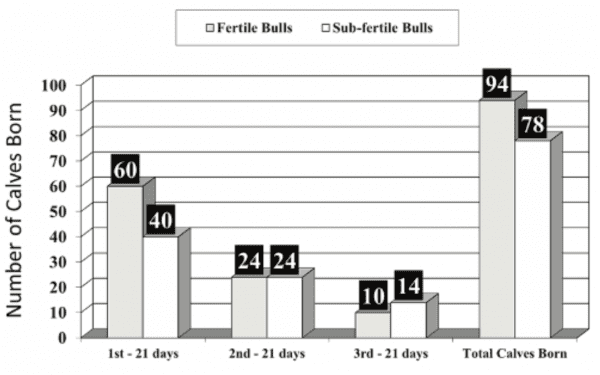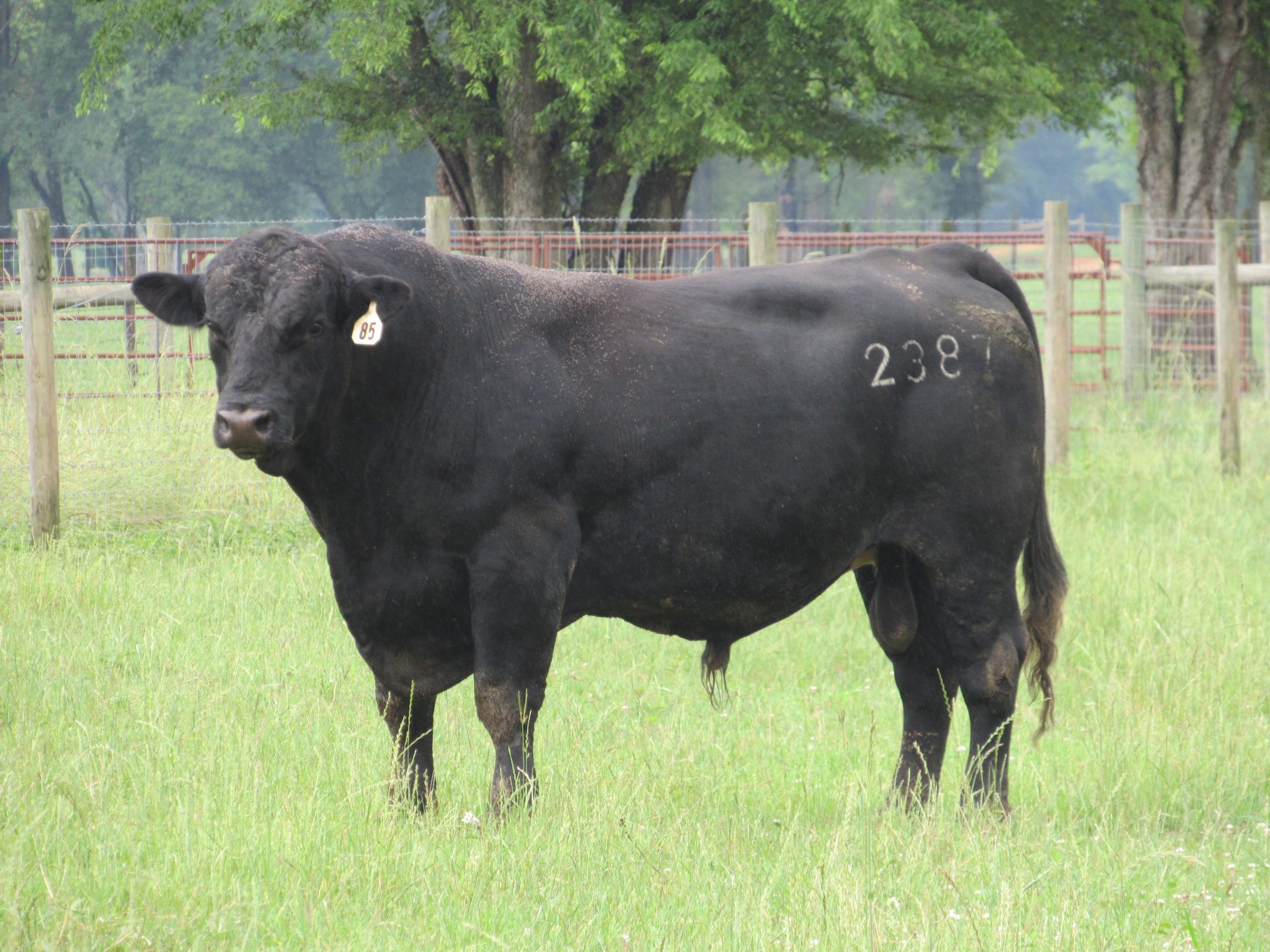Beef

Learn the components of a bull breeding soundness exam and why this practice is essential to every cow-calf operation.
A bull breeding soundness evaluation is a uniform method of assessing a bull’s likelihood of accomplishing pregnancy in an appropriate number of open, healthy, cycling cows or heifers during a defined breeding season. It is one of the most important, yet often neglected, reproductive management practices in cow- calf operations. Failure to properly evaluate the breeding ability of bulls can result in significant economic losses.
BSE Assessments

Figure 1. Estimated pregnancy and calving rates grouped by bull fertility based on a 63-day breeding season with 100 cows
A bull breeding soundness exam (BSE) is more than just a semen exam. A complete BSE evaluates the physical characteristics of a bull necessary for mobility and athleticism in the pasture, structural soundness, overall reproductive development, testicular size and health, and semen quality. A BSE helps to identify bulls that have undesirable traits and are unlikely to achieve a high pregnancy percentage over the course of a defined breeding season.
Bull fertility is classified as fertile, subfertile, or sterile. There are very few sterile bulls. Most bulls eventually will get cows pregnant if they are left together long enough. Subfertile bulls take longer to get cows pregnant than do fertile bulls (figure 1). This means that calves will be born later in the calving season and therefore be younger and lighter at weaning (figure 2). Subfertile bulls also produce fewer calves during a defined breeding season. This leads to less total pounds to market, which translates to fewer dollars in your pocket (figure 3a and 3b). In other words, money will be lost when using subfertile bulls.
Figure 2. Estimated difference in weaning weights due to calf birth dates based on a 63-day calving season
| Calving Period | Calf Weaning Weight | Difference/ Head |
|---|---|---|
| 1–21 days of calving season (226 days of age 2.1 lb/day) + 75 lb BW = | 549.6 lb | Base |
2–21 days of calving season (205 days of age 2.1 lb/day) + 75 lb BW = | 505.5 lb | - 44 lb |
3–21 days of calving season (184 days of age 2.1 lb/day) + 75 lb BW = | 461.4 lb | - 88 lb |
Figure 3a. Estimated economic impact of bull fertility based on a 63-day breeding season with 100 cows. – Fertile Bulls
A difference of $13,719 in gross revenue
Assuming 4 to 6 bulls are used to breed the 100 cows, that represents $2,286.50 to $3,429.75 additional revenue per fertile bull.
| Number of Calves from Figure 1 | Avg Weaning Weight (lb) from Figure 2 | Total Calf Pounds |
|---|---|---|
| 60 head | 549.6 | 32,976 |
| 24 head | 505.5 | 12,132 |
| 10 head | 461.4 | 4,614 |
| 49,722 total lb @ $1.50/lb | ||
| $74,583 gross revenue |
Figure 3b. Estimated economic impact of bull fertility based on a 63-day breeding season with 100 cows. – Subfertile Bulls
A difference of $13,719 in gross revenue
Assuming 4 to 6 bulls are used to breed the 100 cows, that represents $2,286.50 to $3,429.75 additional revenue per fertile bull.
| Number of Calves from Figure 1 | Avg Weaning Weight (lb) from Figure 2 | Total Calf Pounds |
|---|---|---|
| 40 head | 549.6 | 21,984 |
| 24 head | 505.5 | 12,132 |
| 14 head | 461.4 | 6,460 |
| 40,576 total lb @ $1.50/lb | ||
| $60,864 gross revenue |
Evaluating Bull Fertility
A BSE consists of the following four components:
- Physical exam. A bull needs to be able to see, eat, smell, and move around to successfully breed cows. A thorough physical exam evaluates the physical characteristics of a bull necessary for mobility and athleticism in the pasture, structural soundness, overall internal and external reproductive tract development, health and conformation of the sheath and prepuce, and more. A recent history of illness or injury also is important because sperm quantity and/ or quality may be temporarily reduced as a result.
- Scrotal circumference. This measurement evaluates testicular size and health as well as estimates the bull’s sperm-producing capacity. Bulls must meet minimum scrotal circumference measurements based on age in order to pass a BSE (e.g., 34 cm for a bull that is 2 years or older).
- Sperm motility. This ensures that the bull is producing sufficient numbers of motile sperm. Bulls must have at least 30 percent motility to pass a BSE.
- Sperm morphology. This ensures that the bull is producing sperm that are properly shaped and capable of fertilization. Bulls must produce at least 70 percent normal sperm to pass a BSE.
Libido and serving capacity are not evaluated as part of a routine BSE. The recommended minimum requirements for scrotal circumference, sperm motility, and sperm morphology are outlined by the Society for Theriogenology. It is important to note that a BSE is not a guarantee of bull performance during a breeding season. Additional factors influencing the number of cows a bull can breed in a season include pasture size and terrain, physical soundness, age of the bull, libido, number of bulls in the group, etc.
Based on the results of the BSE, a bull is then assigned to one of three classifications:
- Satisfactory potential breeder (fertile). This classification indicates that the bull passed a physical exam; met the minimum requirements for scrotal circumference; has at least 30 percent sperm motility; and produces at least 70 percent normal sperm.
- Unsatisfactory potential breeder (subfertile or sterile). The bull did not pass at least one of the four components of the BSE.
- Deferred. The bull did not pass at least one of the four components of the BSE due to a condition that may resolve with time and/or proper treatment (e.g., foot rot or some other recent illness, infected corns, etc.). A deferred bull should be treated for any potential underlying problems and rechecked at a later date.
A BSE does not ensure that a bull will remain a satisfactory potential breeder the entire breeding season, as it is an assessment of fertility at that time. If a bull suffers injuries to his feet, legs, reproductive tract, etc., he may be rendered incapable of breeding your cows. Therefore, it is extremely important to observe your bulls regularly to ensure that they are doing their job. A BSE also does not guarantee that bulls are free of infectious diseases, so consult with your veterinarian on what diagnostic tests may or may not be appropriate for your bull.
Bull BSEs need to be conducted on an annual basis at least 60 to 75 days before the breeding season in order to allow ample time to replace any unsatisfactory bulls and/or treat and then retest any deferred bulls. Even if the breeding season is less than 60 days away, it is still better to check your bull now than to find out during the next pregnancy exam or calving season that he didn’t perform to your expectations. The extra pounds of beef per exposed cow will more than pay for the BSE, so contact your veterinarian for a bull BSE prior to the breeding season.
Download a PDF of Bull Breeding Soundness Examinations, ANR-1335.


